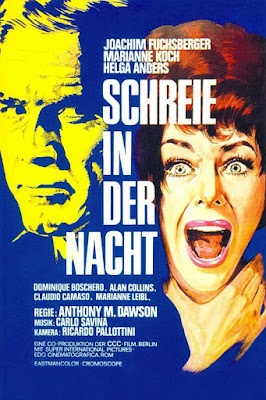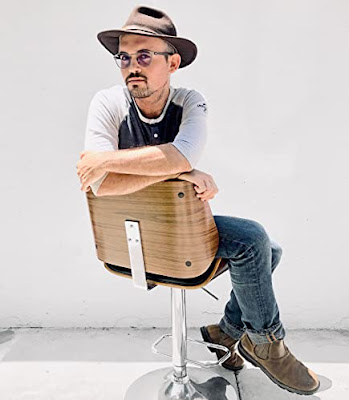After posting my recent link to Ansel Faraj’s Rondo Awarding winning short film The Thousand and One Lives of Doctor Mabuse (2020), I revisited an old interview I did with him in 2013 covering his first two Mabuse related movies.
It was initially meant to accompany an article I had written for VAN HELSING’S JOURNAL about the series of six German Dr Mabuse movies from the 1960s.
Alas, that magazine folded before those two pieces could be published.
Last year I finally published that article as The Many Masks of Dr. Mabuse: Mabuse in the 1960s in eBook format, however, as Ansel’s movies were outside the actual scope of that booklet I had not included the interview.
Time to make amends and finally have if officially made available for this blog.
Make sure to visit the website of Hollinsworth Productions for the availability of those two films and Ansel’s other projects since that interview.
I finished my piece about the 1960s Mabuse series with a reminder that “Mabuse will always be with us”. And just before going to press we learned about the existence of two new Mabuse movies, Doctor Mabuse (2013) and Doctor Mabuse: Etiopomar (2014) and got in touch with Ansel Faraj, the director, for an exclusive interview. Ansel, thanks for doing the interview.
Can you tell us a little bit more about yourself and your previous work?
I was born in Los Angeles, and grew up here - and LA is very much an industry town, you can't drive two blocks without seeing some film crew or signs directing you to a set, and movies always interested me - anything is possible in the movies. So when I was 6 years old, I made up my mind that I was going to be a film director. And now I am 21 years old, and I guess you could say I now am a film director. I started with an old VHS camera and action figures, and then friends from school, and just kept filming and making movies, and as I got older, the movies got better.
Do you have an elevator speech about the two new Mabuse movies that you wrote and directed?
They are apocalyptic fables of evil and corruption - the manipulation and dehumanization of society. Of course that sounds very heavy and philosophic and analytical - so here's my summer popcorn pitch: they are dark comic book stories about the ultimate mastermind - Dr. Mabuse - and his drive for survival in a world that is changing. How can Dr. Mabuse try to keep control? He decides to start his own world that lives by a doctrine which he wrote.
How did you get involved with the Mabuse project?
I saw Fritz Lang's THE GAMBLER when I was about 15, and just liked the character of Mabuse. I wanted to do something with him, and a story fell into my head. I wrote the story when I was 16 and then developed it into a full original screenplay. It's my own interpretation of the character, not a remake or sequel or adaptation or anything like that. It's my own project.
How familiar are you with the various incarnations? Have you read the original novels? Are you aware of the German series of 1960s movies?
I did a lot of research, I read David Kalat's fantastic study THE STRANGE CASE OF DR. MABUSE, I had seen TESTAMENT OF DR. MABUSE (Lang's version, not the remake) after I saw THE GAMBLER, but when I was writing my story, I did not watch any of the other films, and that continued into the production of the film a couple of years after. I did not want to be influenced by anything that came before. I do have the box set of the 60's films - but I've still to watch them.
What do you find fascinating about the character of Dr Mabuse?
I find his methods fascinating. He's a master of disguise, a master of hypnosis, an illusionist, and he uses these techniques to get what he wants. He's a super-genius, and the first I feel, true super villain in literature. His goal is to rule the ashes, to be last man standing - and he'd do it just because he can. That is very interesting and disturbing to me. We do something different in our films, instead of him just wanting to 'rule the ashes', he wants to rule his own world, which is a bit more of the classic Lex Luthor style-villain, but it's really so he can retain control of his power. The world is changing and there's an element of magic to the character of Mabuse. If this dark magic in the world is dying - let's say - and this "magic" is what keeps him going, then he'd do everything in his power to make sure he still exists no matter what - he still wants to be last man standing. That's what we explore, how far will he go to survive.
Is Doctor Mabuse primarily based on the original books or the cinematic adaptations or is that more a riff on the concepts?
No it's completely my own. I took the character, tore him apart, took what I liked about him, added some of my own insanity to him, and built him back up again into my own version. There are some nods to his origins of Norbert Jacques and Fritz Lang, but the rest is all me.
I noticed that you carried some of the original character names over and even managed to slot in a Madame Von Harbau? Is the film set in Germany?
No, it's set in a netherworld really. I wanted it to have the feel of a Universal Monster movie, the movies I was brought up on. You're never quite sure if its turn of the century or if it's 1940, if you're in America or England or Germany.... its off in its own never-never land, and I think that is the best setting for a character like Dr. Mabuse, because then it allows you to work in metaphor.
You can make statements about the world today without having to directly connect to the present. As far as the character names, yeah, they're sort of inspired by characters from the past, but not necessarily based on exact people. Like the City General Oscar Lang, his namesake is Fritz Lang and Madame Von Harbau's namesake is Thea Von Harbau. I'm a bit of a geek.
In previous reviews the film has been described as having a Noir feel. Do you feel that’s an appropriate description? What mood were you aiming at?
Yes, definitely with Doctor Mabuse I set out to make a noir. Robert Aldrich's Kiss Me Deadly was a huge influence on the film. Noir lends itself well to the material because of its archetypes. You can rely on those to help build the story and to navigate it. You have the tormented detective, the femme fatale, the big bad guy, the wormy Elisha Cook Jr. henchman, the dark foggy streets and all of that great nihilism that classic noirs have, and it's such a rich world to set a movie like Doctor Mabuse in. With the second film, we veer away from noir and go more into.... a type of neo-medieval fantasy. It's like an Arthurian-Macbeth feel in slightly modern dress and design.
For the movie you managed to work with Jerry Lacy, Kathryn Leigh Scott, and Lara Parker, from Dark Shadows. How did that come about?
The whole time I was writing the script, I kept thinking 'Wouldn't Jerry Lacy be diabolical as Mabuse?' I kept hearing his voice saying Mabuse's lines as I would write them, but I never thought I'd ever get him – it was just a pipe dream. There was just no way I thought he would do a movie that was being directed by a 19 year old kid. The same thing happened with Madame Carrozza and Madame Von Harbau. As I was writing, I kept imagining Lara and Kathryn in the roles. So you can imagine my excitement when they all agreed to play these parts. It was luck, really.
Do you have any anecdotes from filming with those three cult actors?
Well the one that sticks out most in my mind was when we were doing a scene between Jerry and Lara, Madame Carrozza is reading Mabuse's fate with Tarot cards, and we were getting ready to shoot the scene, and Lara said to Jerry: "Doesn't this bring back memories?" and that got me all giddy inside, because it's been 47 years since they acted onscreen together in Dark Shadows, and now I had them reunited on screen doing something very Dark Shadows like. It made me happy .
I notice that for the second movie Doctor Mabuse: Etiopomar you referenced the fictional nation Eitopomar that Norbert Jacques’ Mabuse was attempting to create in South America. This part of Mabuse’s motivation was mainly left out in previous cinematic incarnations. How important is that for your character?
That's true, Etiopomar is something they never did in any of the Mabuse movies, which is why it was attractive to me to use it in mine. In my "Mabuse mythology", Etiopomar is the name of his new world, and it means 'City of Ashes'. It's what Mabuse is working towards, rather than build a new utopian society in the jungles of South America, he's going to just manipulate his way into taking control of this unnamed city (where the film takes place), and rename it Etiopomar, and it will be the capital city in his new world.
Are the movies considered a 2-parter or can they be viewed independently?
No, they each stand very much on their own. It's not a situation like how THE GAMBLER has Part One/Part Two, but together make up one complete film. In MABUSE and ETIOPOMAR, there are a couple of threads that tie them together into - I guess you could say a double feature, but they are so different in style and tone that I consider them each their own film.
I notice that the second film also features a character called Rotwang. Is that just another Langian reference or really the character from Metropolis?
Yes, Rotwang is in there. He and Maria the Robot. They're both very different in my film, they are inspired by the Metropolis characters, but there's a few things about this Rotwang that make him decidedly different. He's a younger character, and he may not be entirely human. They've both been reinvented for my Mabuse-world.
What are your future projects?
This December I have a sci-fi road movie/unconventional superhero mash up called The Rising Light coming out. It's going to be released online and it stars Mabuse alumni Nathan Wilson, Kathryn Leigh Scott, and Linden Chiles; and next year I hope to start filming another dream project of mine, a cyberpunk mystery-comedy. I've got quite a bit coming up.
Finally: Where can the films be seen and is there a DVD release due shortly?
Doctor Mabuse is being released on DVD this November, you'll be able to purchase it online; and its follow up Doctor Mabuse: Etiopomar will be premiering in Los Angeles in April 2014 with a limited theatrical run in LA immediately following, and then a few screenings in New York in the summer - and then of course a DVD next fall.
>









